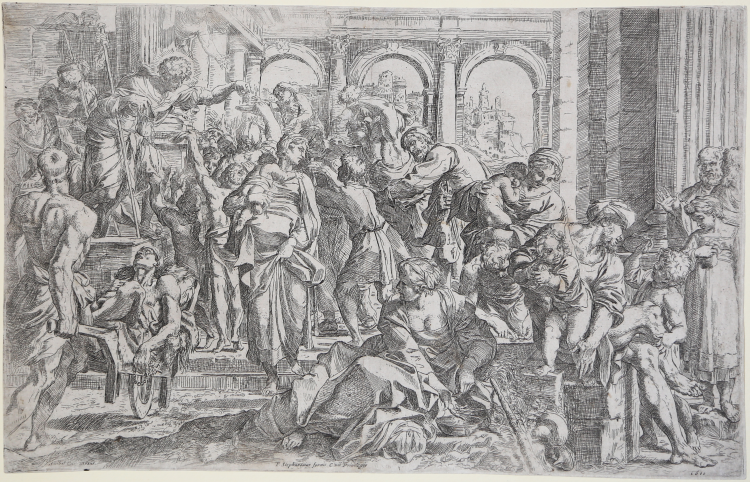



| Reference: | S21462 |
| Author | Francesco BRIZIO |
| Year: | 1602 ca. |
| Measures: | 455 x 290 mm |



| Reference: | S21462 |
| Author | Francesco BRIZIO |
| Year: | 1602 ca. |
| Measures: | 455 x 290 mm |
St Roch distributing alms to the poor, after Annibale Carracci.
Example of the second state of three, with new lettering added: 'Anibal Car invent', the date 1610, and the address 'P Stefanonius formis cum privilegio'.
A fine impression, printed on contemporary laid paper, trimmed to the platemark, very good condition.
|
TIB 4003.049, II/III.
|
Francesco BRIZIO (Bologna 1574 - 1623)
|
Italian painter, draughtsman and engraver. He studied with Bartolomeo Passerotti and afterwards at the Accademia degli Incamminati, founded by the Carracci, where he participated in group projects supervised by Ludovico Carracci. These included frescoes (c. 1598–1600) in the Palazzo Fava in Bologna depicting scenes from the Aeneid (he very likely worked on the last room, in collaboration with Leonello Spada); decorations (c. 1600) in the oratory of S Maria dell’Orazione annexed to the oratory of S Colombano, Bologna (Road to Calvary); and others (1604–05; almost invisible) in the octagonal cloister of the monastery of S Michele in Bosco, Bologna (Three Stories of St Benedict). He was left in charge of the workshop while Ludovico made a brief visit to Rome in 1602, suggesting that he held a prestigious position (although the best pupils had by then already left). Brizio continued to work with Leonello Spada and Lucio Massari, more gifted painters whose work has elements in common with his. They collaborated on frescoes in the Palazzo Bonfioli–Rossi in Bologna (1604–5) and the oratory of the Trinity at Pieve di Cento (c. 1605). His loyalty to Ludovico Carracci’s style is evident in numerous altarpieces that remain in Bolognese churches, such as S Domenico, S Martino and S Salvatore, and in paintings in the Pinacoteca Nazionale, Bologna, and the Pinacoteca di Brera, Milan. Malvasia praised his ability to organize large-scale compositions with many figures, as in the Coronation of the Virgin of St Luke (1618; Bologna, S Petronio). Not a highly gifted painter, but noted for his witty narratives, he occupied a secondary role in the figurative Bolognese tradition. His work as a draughtsman and engraver is also noteworthy
|
|
TIB 4003.049, II/III.
|
Francesco BRIZIO (Bologna 1574 - 1623)
|
Italian painter, draughtsman and engraver. He studied with Bartolomeo Passerotti and afterwards at the Accademia degli Incamminati, founded by the Carracci, where he participated in group projects supervised by Ludovico Carracci. These included frescoes (c. 1598–1600) in the Palazzo Fava in Bologna depicting scenes from the Aeneid (he very likely worked on the last room, in collaboration with Leonello Spada); decorations (c. 1600) in the oratory of S Maria dell’Orazione annexed to the oratory of S Colombano, Bologna (Road to Calvary); and others (1604–05; almost invisible) in the octagonal cloister of the monastery of S Michele in Bosco, Bologna (Three Stories of St Benedict). He was left in charge of the workshop while Ludovico made a brief visit to Rome in 1602, suggesting that he held a prestigious position (although the best pupils had by then already left). Brizio continued to work with Leonello Spada and Lucio Massari, more gifted painters whose work has elements in common with his. They collaborated on frescoes in the Palazzo Bonfioli–Rossi in Bologna (1604–5) and the oratory of the Trinity at Pieve di Cento (c. 1605). His loyalty to Ludovico Carracci’s style is evident in numerous altarpieces that remain in Bolognese churches, such as S Domenico, S Martino and S Salvatore, and in paintings in the Pinacoteca Nazionale, Bologna, and the Pinacoteca di Brera, Milan. Malvasia praised his ability to organize large-scale compositions with many figures, as in the Coronation of the Virgin of St Luke (1618; Bologna, S Petronio). Not a highly gifted painter, but noted for his witty narratives, he occupied a secondary role in the figurative Bolognese tradition. His work as a draughtsman and engraver is also noteworthy
|